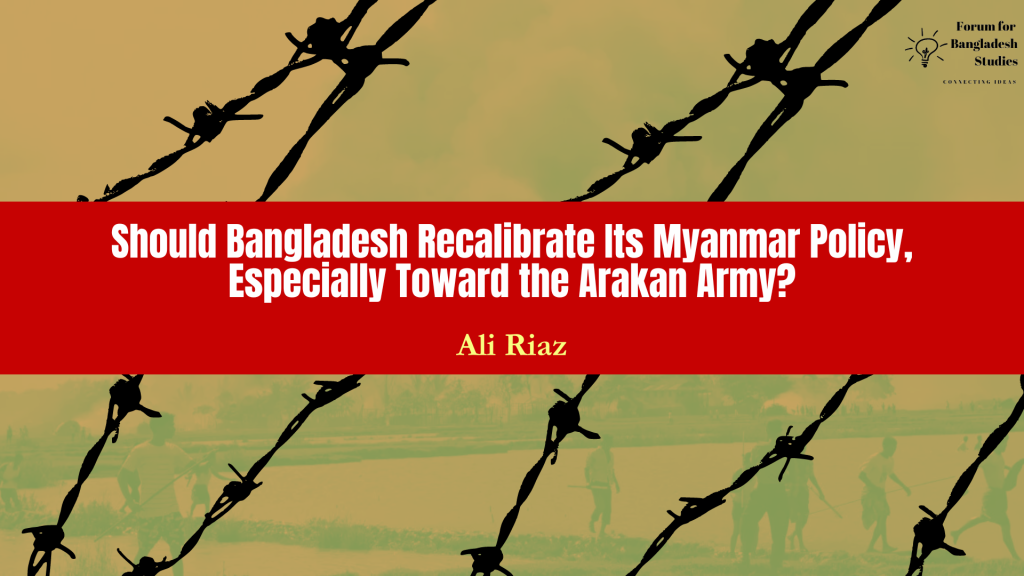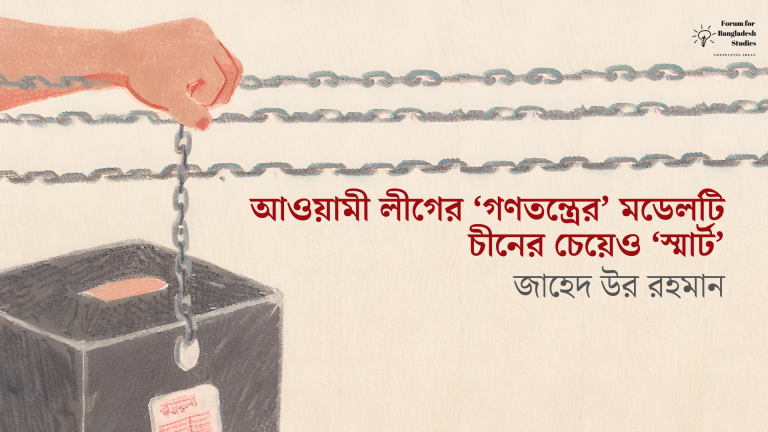Since the Three Brotherhood Alliance. a coalition of three ethnic armed organizations (EAOs) — the Myanmar National Democratic Alliance Army (MNDAA), the Ta’ang National Liberation Army (TNLA), and the Arakan Army (AA) — launched Operation 1027 against the military junta on October 27 last year, Myanmar’s long-running civil war has taken a new turn.
Its impact is not only being felt within Myanmar. Increasingly, the conflict is becoming a regional security issue with implications for neighboring countries, including Bangladesh.
Fighting in various regions of Myanmar has intensified in the past months and news of the Army’s defeat in three states – Rakhine, Chin, and Shan – is reported almost every day. Rakhine State, where the AA is undertaking a military offensive, has been restive for years and is home to the Rohingya community. In 2017, more than a million Rohingya fled their homes to take refuge in Bangladesh after the military perpetrated a genocide. Myanmar has been dragging its feet to take back these refugees, despite China’s half-hearted mediation that culminated in a bilateral agreement signed with Bangladesh in 2017.
The clash between the rebels and the military is not confined to Myanmar’s territory but is spilling over the Myanmar-Bangladesh border as mortar shells are landing on the Bangladesh side. Two Bangladeshis have died and panic among people living along the border has spread in the past weeks.
In addition, at least 340 members of the Myanmar security forces have fled to Bangladesh. While the chief of Bangladesh’s Rapid Action Battalion (RAB) warned that the Myanmar junta is trying to wage a war against Bangladesh, security analysts have discounted the possibility of a full-scale war. But the recent developments within Myanmar, especially in Rakhine State, have engendered the possibility that the junta will be severely weakened and that some of the states will be able to secure autonomy. This will usher in a new era in Myanmar.
As for the Rakhine State, the possible victory of the AA raises the hope that the Rohingya refugees may be repatriated in the future.
Geographical proximity and the actors involved in the conflict are bound to pull Bangladesh into the conflict, sooner or later. Notwithstanding the intensification of the conflict, the capturing of Taung Pyo Let Yar outpost in Maungdaw township and the response of the Myanmar Army are bringing the battle to the doorstep of Bangladesh.
The AA, fighting to “restore sovereignty of the multi-ethnic Arakanese,” is composed of Buddhists; the Rohingya are majority Muslim. However, there are reports that Rohingya from within Myanmar are joining the AA, believing that expulsion of the junta government from Rakhine State and establishing a “free zone” would allow them to restore their properties and homes.
However, many Rohingya refugees who are in the camps in Bangladesh are skeptical about their future even if the AA succeeds, as the AA is yet to recognize Rohingya citizenship rights.
The conflict in Myanmar, especially in Rakhine, not only involves the junta and the rebels, but also the two regional powers’ economic and strategic interests.
China, which has a longstanding relationship with the Myanmar government and has continued its support to the junta after the coup in 2021, albeit cautiously, has a stake in the area. It includes the newly built Kyaukphyu port on the Bay of Bengal and a pipeline and planned road and rail links between the port and southern China. The $7.3 billion project is an important element of its Belt and Road Initiative (BRI).
India, on the other hand, has the Kaladan Multi-Modal Transit Transport project costing $484 million, which includes a port in Sittwe connecting Kolkata with its landlocked northeast through western Myanmar’s Rakhine and Chin States, bypassing Bangladesh. Paletwa township in Chin State is a key point for the project, which has been captured by AA forces. The Indian project was developed not only for economic reasons but also to counter Chinese influence in Myanmar and to have a presence in the Bay of Bengal, an integral part of the Indian Ocean.
The AA’s advance in Rakhine is a deeply concerning development for India. India is already facing challenges regarding Chin rebels along the Mizoram border due to the ethnic relationship between inhabitants on both sides of the border. Since the conflict intensified, refugees and Myanmar soldiers have crossed the border to take refuge in India.
The AA reportedly has China’s backing and has promised to protect Chinese interests, whereas it has made no such commitment to Indian investments. China has maintained close relations with these EAOs while India shunned the rebels and put all its eggs in the junta’s basket. As such, India would like to see the AA’s advance contained, and the Myanmar Army restoring its control over the region. Yet if the gains made by EAOs over the past three months are any indication, the return of the pre-October situation is unlikely – not only in Rakhine but also in Chin and Shan states.
Undoubtedly, the continued escalation of conflict in Rakhine State and possible advances of the AA will have serious implications for Bangladesh. The impacts will not be limited to the ground in the border areas, but also Bangladesh’s foreign relations will be impacted. Undoubtedly, Myanmar will be closely watching. Additionally, considering the interests of China and India in Rakhine and Bangladesh’s close relationship, they too will be paying attention.
The United States too is concerned that the current conflagration in Myanmar may cause security challenges in the region. The recent visit of a U.S. delegation led by the National Security Council’s Senior Director Rear Admiral Eileen Laubacher to Bangladesh is a clear indication in this regard. In its meetings with Bangladeshi officials, the U.S. delegation drew attention to security concerns.
It is against this background that Bangladesh needs to consider whether it should explore various options and recalibrate its policy about Myanmar, particularly toward the AA. The situation offers Bangladesh three options: maintaining the status quo, working with the AA, or taking a proactive stance in containing the AA’s advance.
Despite recent developments, the Bangladesh government has maintained an apparent neutrality and simply protested the Myanmar Army’s intrusion into Bangladesh’s territory. As the junta is unlikely to fall, even with the loss of Rakhine and a few other states, Bangladesh’s policy in this regard is not unusual. But as the situation worsens, there is a possibility that a new wave of refugees from Rakhine will arrive in Bangladesh, which the latter is unwilling to accept. Stopping these refugees with force will be difficult and will contribute to further deterioration of the border situation.
As such, the status quo is increasingly becoming untenable. This option keeps other actors, especially China and India, somewhat content. But continuation of this policy, which implies that Bangladesh ignores the AA, will be determinantal to the interests of the AA and bound to engender a strained relationship with the group, causing more problems in the coming months.
The second option is to establish informal contacts with the AA and the National Unity Government (NUG), laying out possible future relations, especially if the rebel forces succeed in establishing an autonomous region like the United Wa State Army, which controls a large territory in Shan State, some of which is formally recognized by the regime. There is no denying that the AA and its political wing, the United League of Arakan, have become a crucial actor.
Engaging with the AA will damage Bangladesh’s formal relationship with the government in Naypyidaw. However, maintaining contact with non-state actors of neighboring countries for security reasons is not entirely an unprecedented step. In engaging the AA, it is not only the Myanmar government that Bangladesh has to be worried about, but also India’s reaction to it. Considering that India is not supportive of the AA’s success — its relationship with the AA has a long history of distrust — Bangladesh’s efforts will be seen as an action aligning with China. As India has been the principal backer of the Hasina regime, the latter is unlikely to make such a move.
It has been said that Bangladesh is working with India to devise a coordinated strategy to deal with the situation. Meetings between India’s National Security Advisor Ajit Doval and Bangladesh government representatives during his brief trip to Dhaka and Bangladesh’s Foreign Minister Hasan Mahmud trip to New Delhi are indications of such cooperation. While this is beneficial to India’s economic and strategic interests, by stonewalling the AA, Bangladesh may lose an opportunity for a better future relationship with the powers in Rakhine and hurt any possibility of repatriation of the Rohingya in the near or distant future.
The third option available to Bangladesh is to actively engage with the Myanmar government to contain the advances of the AA as the border situation gets more restive. This will turn the conflict into a battle between Bangladesh and the AA and will draw the Rohingya openly into the conflict. Such a measure will engulf the region in a tripartite war, between states and between states and non-state actors. This will be a perilous path for the country. Understandably, India, China, and the United States will not be supportive of such a situation.
Faced with these three options, Bangladesh needs to revisit its current approach toward the evolving situation and the actors engaged in the conflict. In doing so, Dhaka needs to consider its best interests and actively pursue them. The situation is changing rapidly, and time is running out.
Originally Published: The Diplomat, March 01, 2024




